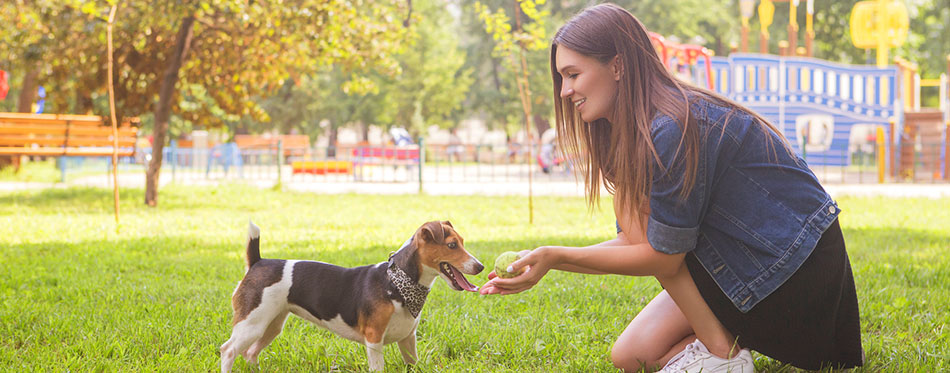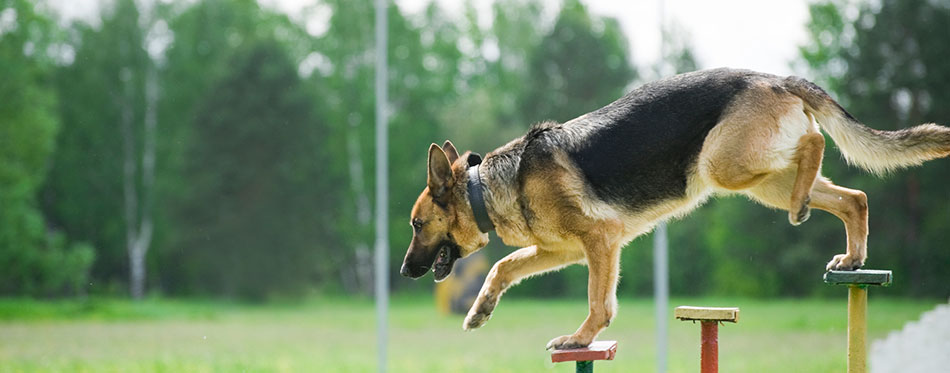A well-behaved dog is always a source of great pride for any pet parent. As dogs follow our commands and exhibit behaviors that we regard as acceptable, our relationship with them grows stronger. It is unfortunate, however, that some pet parents seem to fail in training their dogs the correct way. It is also sad that there are no foolproof ways to train dogs as a species. Like us, dogs have their own characteristics and personalities that can get in the way of effective training. Nevertheless, there are always principles that we can adhere to if we want to train our dogs in a positive way. Here are 10 essential tips to ensure more positive dog training sessions.

1. Start Training Your Dog as a Puppy
If you believe in the phrase ‘tabula rasa’, then you know that you should start training your dog while it is still a puppy. Starting training on a “blank slate” is more effective than overwriting what the dog already knows.
Like babies, puppies can learn to take in and process a lot of information into their developing brain. A puppy’s brain doesn’t contain much information about the world yet. It doesn’t know which behavior is acceptable and which ones are undesirable. As such, when you housetrain your puppy, it will learn where to do its business. It will learn that your home is not its personal commode. The same is true when teaching your dog the recall. It learns that when it hears its name, it will come to you.
Think of it this way. You will have a much better chance of growing a well-behaved dog if you fill its mind with more positive things. You can further enhance this by starting the training as early as 6 to 8 weeks old. Now try training a dog that is already 5 or 6 years old. This means the dog already has 5 to 6 years’ worth of information. If most of these behaviors are undesirable, it will be very difficult to undo them. So, start them young.
2. Look for a Training Model that Suits Your Dog
Most newbie dog owners fail to take into consideration the unique temperaments of their pet. Like in other situations, there is no such thing as a one-size-fits-all dog training model.
It is important to understand that different dogs will respond to training methods in different ways. There are dogs that respond well to the use of treats during training. Others are more responsive if you use praises and lots of hugs. There are also dogs that prefer a combination of affection and dog treats. There are dogs that respond to the use of clickers while others prefer using verbal cues. The point is to look for a training model that suits your pet.
You can read books about dog training styles, but make sure to read not only one. You can also ask your veterinarian for tips on how you can train your dog. If you have a friend who has an extensive experience with dogs, you might want to seek his or her opinion as well. You can then try these training styles on your dog to see which one works. You can also design your own dog training program this way. What is important to keep in mind is to never give up too fast. It is also important not to be afraid of change. If your dog training style is not producing the results you want, then change it up. For more options, check out our detailed review of dog training books.
3. Be Consistent
Consistency can go a long way in training your dog. It is all about avoiding confusion in your pet. If you use a verbal cue in teaching a particular behavior, make sure to use this ‘magic word’ throughout the training course.
The same is true when teaching your dog certain ‘rules’ in your house. If you don’t want your pet to jump onto the couch, then you should be consistent about this ‘rule’. The problem is that there will be times when you think you want to cuddle with your dog. In such instances, you will allow the dog to stay on the couch with you. This will confuse your dog. Why? It knows that it should not go up the couch. It doesn’t know that it can stay on the couch if you want to cuddle with it. Your dog will never understand why there are certain times when it is okay to be on the couch and there are times when it’s not okay.
This also means that every member of your household should know about the ‘rules’ you have for your dog. If you are teaching your dog not to beg for food while you’re having dinner, make sure that everyone else understands this. They should also not give in to your dog’s begging tendencies.
4. Be Patient
Some dogs are fast learners while others may take several sessions before they learn what you’re teaching them. Keep in mind that different dogs progress through their training at different paces. Don’t get frustrated if your dog doesn’t ‘get it’ the first time or the second time. Patience is a virtue of all dog trainers. Pet parents should have this, too.
There are also instances when you forget about the length of the training session. As a guiding principle, dog training sessions should not last longer than 15 minutes. Intelligent dogs like Border Collies and Poodles require only 10 minutes of training. Why is that? Smart and intelligent breeds can grow bored real fast. They are quick to learn. If you train them, make it short but fun.
One good way to keep the training sessions short is by breaking it up into smaller parts. This is important for dog behaviors or skills that require several “skills” to accomplish. For instance, in teaching your dog to roll over, it needs to learn to sit and lie down first. You will also need to break down the ‘rolling’ part.
Check out our guides on Dog Agility Tunnels and Dog Treadmills for more info.

5. Understand that Timing is Critical
Marking the behavior you want from your dog is crucial in reinforcing such behaviors. Timing is critical when it comes to training your dog. Dog trainers recommend using a dog training clicker to mark the behavior. You can also use a short word as a behavior marker. You can say “yes” to mark the behavior, for example. The usual sequence is dog behavior, marker, and treat. Other forms of positive reinforcement like praise also work.
The span of time between the marker and the positive reinforcement should be very short. It is best if you can give the positive reinforcement within a second of marking the behavior. For example, once your dog completes the behavior you want, activate the clicker or say “yes”. As soon as you activate the clicker, give your dog the treat.
There are two things that you want your dog to associate. First is between the behavior and the sound of the clicker or “yes”. Second is between the marker and the treat. Over time, your dog will learn to associate the treat or reward with the behavior.
6. Avoid Punishment
There are some pet parents who believe in the use of harsh punishments in training dogs. Aversive training is never productive. However, mild aversive methods may help in certain situations. For example, squirting water into your dog’s face is an aversive method that will not hurt your dog. However, if your dog catches you doing this it can result in confusion in your dog.
Staring down, yelling, and hitting your dog will never bring the results that you desire. Instead, these harsh punishment methods can trigger an aggressive reaction from your dog. It may snap and bite you. Worse, your dog may vent its ire on other people or objects.
Punishments can also make your dog more fearful. It may go into depression which can lead to more serious behavioral problems. Some punishment can also harm your dog. For example, there are pet owners who consider shock collars as safe. We may not see burn injuries on the skin of dogs with shock collars. But we also don’t know if there are already injuries in the underlying tissues where the electric shock travels to.
7. Don’t Reinforce Undesirable Behavior
It is unfortunate that many pet parents are guilty of reinforcing the dog’s undesirable behaviors. What makes it sadder is that we are not aware that the things we do are reinforcing the behaviors we don’t want our dogs to show.
For example, we often find ourselves rushing in to our dog’s side whenever there is a thunderstorm. It is afraid of the loud noise. Our natural instinct is to comfort our dog. We are reinforcing our dog’s anxiety this way. It learns that whenever there is a loud noise, it can rely on you to comfort it. The same is true when they jump at us at the door after coming home from work. Most of us will pet them and hug them in an instant. We are also reinforcing their behavior. What we need to do is to let them calm down first before we resume our normal interaction with them.
Dogs love the attention they get. And if you are not careful in the giving of such attention, you may be reinforcing the very same behavior you don’t want your dog to do.

8. Don’t Train Your Dog if It is Anxious or You Are
A dog that is calm is a lot easier to train than one that is anxious and hyperactive. The same is true with a dog owner who is very anxious about training his or her pet. As such, it is best to schedule your training sessions when both of you are in a calm state.
Some say it is best to walk your dog before engaging in its training for the day. While this may work, you should not overdo it. If your dog gets tired during the walk, it may no longer have the interest to engage in training. It no longer has the energy to follow your commands. As such, it is important to keep the walk short if you want your dog to have energy left for the training. Playing with your dog for about 2 to 5 minutes is often enough to put them in a calm state.
On the other side of the equation is your own state of mind. If you are anxious, you may grow impatient. You may yell at your dog if it doesn’t get the action right. Make sure you’re not anxious when you do train your dog.
9. Practice the Desirable Behavior in Different Settings
Many pet parents forget that proofing the behavior is important in dog training. This means you need to practice the desirable behavior in different settings. You can expose your dog to different distractions while performing the desirable behavior. This can cement the behavior you want from your dog.
If you are training your dog to sit, don’t do this only in your living room. Make sure to train your dog to sit also in the backyard or anywhere else that you deem safe. It is important to train your pet in a quiet environment that’s free from distractions. This is the first step. Once your dog has mastered the behavior, you can initiate training it in environments with distractions.
You may also like our articles on Dog Whistles and Dog Silencers.
10. End Training Sessions with Something Positive
An important part of dog training is the use of positive experiences right after each training sessions. You can always end with a handful of delicious treats. You can also lavish your dog with praises. Some pet parents will give their dogs 5 to 10 minutes of meaningful play.
These positive experiences are your dog’s reward for obeying your commands. In a way, you are teaching your dog to work for whatever it is it considers pleasurable.
Training your dog may not be easy for beginners. But there are countless tips you can adhere to if you want your dog to become a well-behaved and well-trained pet.
Sources:
- Dog 101: How to Train Your Dog – PetMD
- How to Train a Dog: Tips and Guidelines – HowStuffWorks

